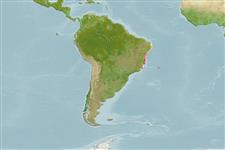Classificatie / Names
Lokale namen | Synoniemen | Catalog of Fishes(Genus, Soort(en)) | ITIS | CoL | WoRMS | Cloffa
>
Blenniiformes (Blennies) >
Blenniidae (Combtooth blennies) > Salariinae
Etymology: poiti: Named after the Oceanographic Post of Trindade Island of the Brazilian Navy..
Environment: milieu / climate zone / depth range / distribution range
Ecologie
marien rifbewoner; diepte 0 - 1 m (Ref. 49353). Tropical
Southwest Atlantic: Trindade Island, Brazil.
Grootte / Gewicht / Leeftijd
Maturity: Lm ? range ? - ? cm
Max length : 8.5 cm SL mannelijk / geslacht onbekend; (Ref. 49353); 8.0 cm SL (female)
Korte beschrijving
Determinatiesleutels | Morfologie | Morfometrie
Dorsale stekels (totaal) : 11 - 12; Dorsale zachte stralen (totaal) : 13 - 15; Anale stekels: 2; Anale zachte stralen: 15 - 16. Diagnosis: This species is distinguished from its Atlantic congeners by its speckled body and head with small black spots (vs. absent in S. cristata); modally 14 segmented dorsal fin rays (vs. 15 of S. cristata from other Brazilian localities, S. caboverdiana, and
S. nuchifilis; and 16 in S. springeri); modally 16 segmented anal fin rays (vs. 17 of S. cristata from other Brazilian localities, S. caboverdiana, and S. nuchifilis; and 18 in S. springeri); modally 19 nuchal cirri (vs. 22 in S. cristata from other Brazilian localities, 5 in S. springeri, 6 in S. nuchifilis, and 17 in S. caboverdiana); and, modally 23 caudal vertebrae (vs. 24 in specimens of S. cristata
from other Brazilian localities, S. caboverdiana, and S. nuchifilis, and 25 in S. Springeri ). The means of counts of dorsal and anal rays are additional diagnostic characters.
Recorded from 0.1 to 1.0 meter depth inside tide pools and in the surf zone over crustose algae or volcanic reefs. Observed to be extremely tolerant to high salinity and temperature variations. Adults occur with other blennies (Ophioblennius cf. atlanticus and an undescribed species of the genus Entomacrodus, labrisomids (Labrisomus nuchipinnis and an undescribed species of Malacoctenus), the Trindade damselfish (Stegastes fuscus trindadensis), and a Brazilian wrasse (Thalassoma noronhanum) (Ref. 49353). Oviparous. Eggs are demersal and adhesive (Ref. 205), and are attached to the substrate via a filamentous, adhesive pad or pedestal (Ref. 94114). Larvae are planktonic, often found in shallow, coastal waters (Ref. 94114).
Levenscyclus en paargedrag
Maturities | Voortplanting | Spawnings | Egg(s) | Fecundities | Larven
Oviparous, distinct pairing (Ref. 205).
Rangel, C.A, J.L. Gasparini and R.Z.P. Guimarães, 2004. A new species of combtooth blenny Scartelly Jordan, 1886 (Teleosteii: Blenniidae) from Trindade Island, Brazil. aqua, J. Ichthyol. Aquat. Biol. 8(3):89-96. (Ref. 49353)
Status op de Rode Lijst van het IUCN (Ref. 130435)
Gevaar voor de mens
Harmless
Gebruik door de mens
Tools
Speciale rapporten
Download XML
Internetbronnen
Estimates based on models
Preferred temperature (Ref.
123201): 25.5 - 25.6, mean 25.6 °C (based on 2 cells).
Fylogenetische diversiteitsindex (Ref.
82804): PD
50 = 0.5078 [Uniqueness, from 0.5 = low to 2.0 = high].
Bayesian length-weight: a=0.01072 (0.00480 - 0.02393), b=3.01 (2.82 - 3.20), in cm total length, based on LWR estimates for this (Sub)family-body shape (Ref.
93245).
Trofisch niveau (Ref.
69278): 2.7 ±0.2 se; based on size and trophs of closest relatives
Weerstandsvermogen (Ref.
120179): Hoog, minimale populatieverdubbelingstijd minder dan 15 maanden (Preliminary K or Fecundity.).
Fishing Vulnerability (Ref.
59153): Low vulnerability (10 of 100).
